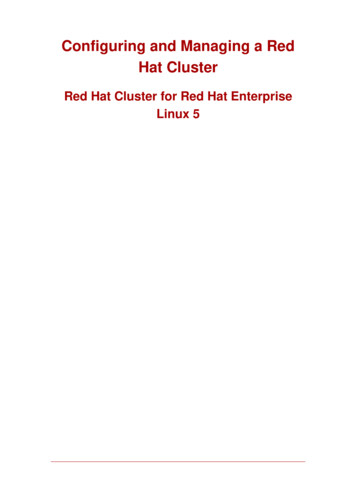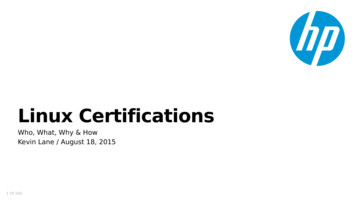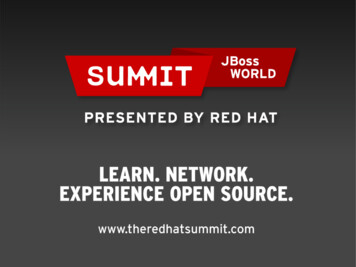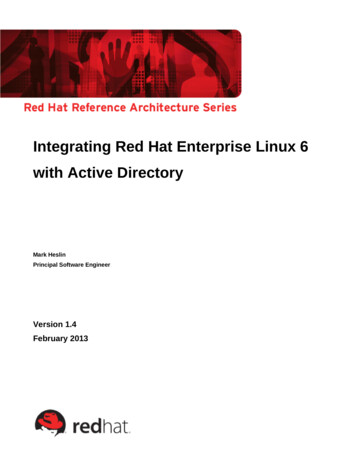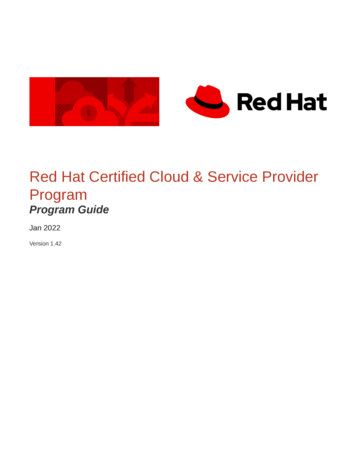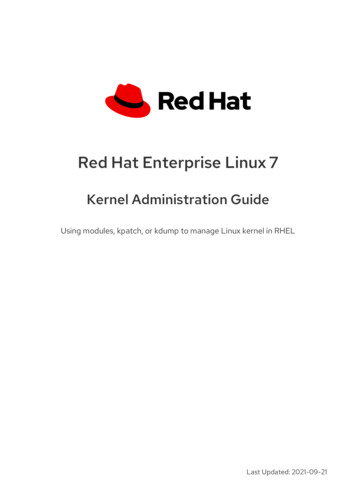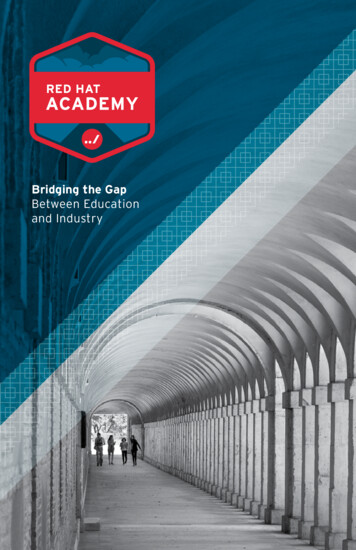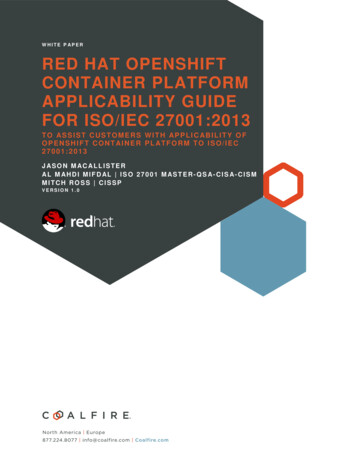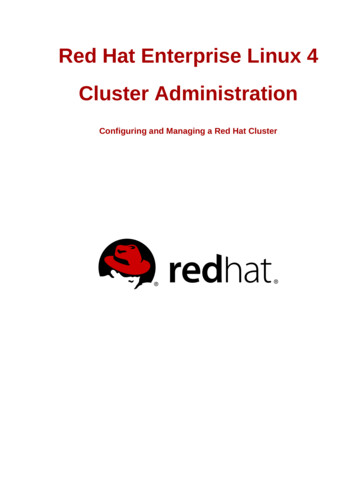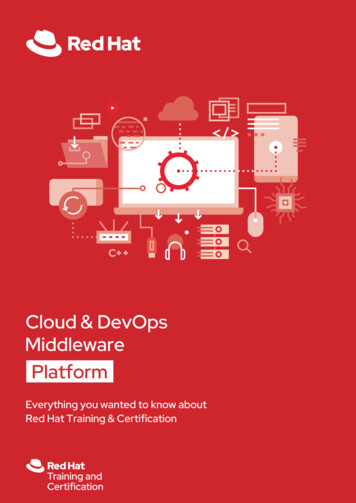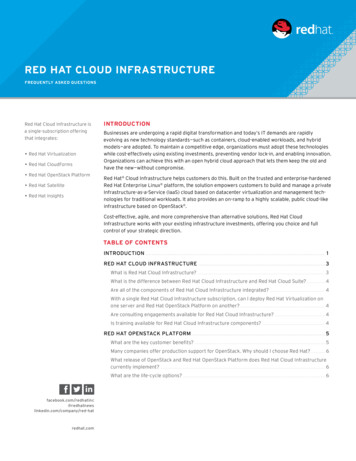
Transcription
RED HAT CLOUD INFRASTRUCTUREFREQUENTLY ASKED QUESTIONSRed Hat Cloud Infrastructure isa single-subscription offeringthat integrates: Red Hat Virtualization Red Hat CloudForms Red Hat OpenStack Platform Red Hat Satellite Red Hat InsightsINTRODUCTIONBusinesses are undergoing a rapid digital transformation and today’s IT demands are rapidlyevolving as new technology standards — such as containers, cloud-enabled workloads, and hybridmodels — are adopted. To maintain a competitive edge, organizations must adopt these technologieswhile cost-effectively using existing investments, preventing vendor lock-in, and enabling innovation.Organizations can achieve this with an open hybrid cloud approach that lets them keep the old andhave the new — without compromise.Red Hat Cloud Infrastructure helps customers do this. Built on the trusted and enterprise-hardenedRed Hat Enterprise Linux platform, the solution empowers customers to build and manage a privateInfrastructure-as-a-Service (IaaS) cloud based on datacenter virtualization and management technologies for traditional workloads. It also provides an on-ramp to a highly scalable, public cloud-likeinfrastructure based on OpenStack .Cost-effective, agile, and more comprehensive than alternative solutions, Red Hat CloudInfrastructure works with your existing infrastructure investments, offering you choice and fullcontrol of your strategic direction.TABLE OF CONTENTSINTRODUCTION. 1RED HAT CLOUD INFRASTRUCTURE.3What is Red Hat Cloud Infrastructure?. 3What is the difference between Red Hat Cloud Infrastructure and Red Hat Cloud Suite?.4Are all of the components of Red Hat Cloud Infrastructure integrated?.4With a single Red Hat Cloud Infrastructure subscription, can I deploy Red Hat Virtualization onone server and Red Hat OpenStack Platform on another?.4Are consulting engagements available for Red Hat Cloud Infrastructure?.4Is training available for Red Hat Cloud Infrastructure components?.4RED HAT OPENSTACK PLATFORM.5What are the key customer benefits?. 5Many companies offer production support for OpenStack. Why should I choose Red Hat?. 6What release of OpenStack and Red Hat OpenStack Platform does Red Hat Cloud Infrastructurecurrently implement?. 6What are the life-cycle options?. pany/red-hatredhat.com
RED HAT CLOUDINFRASTRUCTUREAT A GLANCE Provides infrastructure asyour needs grow — fromtraditional applications toprivate, hybrid, and publiccloud environments Meets private cloud usecases based on existingdatacenter virtualization,traditional workloads, andhybrid deployment models Provides a public cloudapproach, reducing thelikelihood of shadowIT occurrencesRED HAT VIRTUALIZATION.6What sets Red Hat Virtualization apart from its competitors?. 6What guest operating systems does Red Hat Virtualization support?. 7Can I download an evaluation version of Red Hat Virtualization?.8RED HAT CLOUDFORMS.8What are the benefits of Red Hat CloudForms?.8What does Red Hat CloudForms provide for virtual and cloud environments?.8How does Red Hat CloudForms extend the management of Red Hat OpenStack Platform?.8How does Red Hat CloudForms enhance Red Hat Virtualization?.9RED HAT SATELLITE.9What benefits does Red Hat Satellite bring to Red Hat Cloud Infrastructure?.9Can I use the Red Hat Satellite instance included in Red Hat Cloud Infrastructure to manageRed Hat Enterprise Linux systems outside my Red Hat Cloud Infrastructure subscription?. 10RED HAT INSIGHTS. 10 Includes the top virtualizationbenchmarks for performanceand scalability1What are the key benefits of Red Hat Insights?. 10 Lets you oversee andorchestrate your entirecloud infrastructure from asingle consoleHow does Red Hat Insights compare to similar products in the market?.11Can I use the Red Hat Insights instance included in Red Hat Cloud Infrastructure to manageRed Hat Enterprise Linux systems outside my Red Hat Cloud Infrastructure subscription?.11 Includes integrated life-cyclemanagement for automatedprovisioning, configurationmanagement, and softwaremanagement of Red HatEnterprise Linux and anyRPM-based application1 http://www.spec.org/virt sc2013/results/specvirt sc2013 perf.htmlredhat.comFAQRed Hat Cloud Infrastructure2
RED HAT CLOUD INFRASTRUCTUREQUESTION: What is Red HatCloud Infrastructure?ANSWER: Red Hat Cloud Infrastructure is a single-subscription offering that consists of severalintegrated Red Hat technologies: Red Hat CloudForms — providing cloud management and orchestration across multiple hypervisors, public cloud providers, and Red Hat OpenStack Platform Red Hat Satellite — providing life-cycle management, including errata management, configuration,and provisioning coverage across all of Red Hat Cloud Infrastructure, from the physical infrastructure itself to tenant workloads Red Hat Virtualization — providing datacenter virtualization hypervisor and management for traditional workloads Red Hat OpenStack Platform — providing a massively scalable, fault-tolerant platform forthe development of a managed private or public cloud environment for cloud-enabled workloads — based on Red Hat OpenStack technology, optimized for and integrated with Red HatEnterprise Linux Red Hat Enterprise Linux — forming the basis of both Red Hat OpenStack Platform and Red HatVirtualization at the hosted operating system layer. In addition, customers can opt to purchaseRed Hat Cloud Infrastructure with unlimited Red Hat Enterprise Linux guests Red Hat Insights — providing predictive analytics and failure detection for all components of theRed Hat infrastructure stackMore information can be found at NTVIRTUALIZATIONPRIVATE CLOUDPUBLIC CLOUDAmazon Web ServicesMicrosoft AzureVMwareGoogle Cloud PlatformMicrosoft Hyper-VPLATFORMSTORAGECL0074-02Figure 1. Red Hat technologies integrated into Red Hat Cloud Infrastructureredhat.comFAQRed Hat Cloud Infrastructure3
QUESTION: What is thedifference between Red HatCloud Infrastructure andRed Hat Cloud Suite?ANSWER: Red Hat Cloud Infrastructure lets you build and manage a private IaaS cloud based ondatacenter virtualization and management technologies for traditional workloads. It also providesan on-ramp to a highly scalable, public cloud-like infrastructure based on OpenStack.However, unlike Red Hat Cloud Suite, it does not provide Platform-as-a-Service (PaaS). Red HatCloud Suite includes all of the infrastructure and management technologies existing in Red HatCloud Infrastructure, as well as Red Hat OpenShift Container Platform, the award-winning, container-based application development platform.In short, Red Hat Cloud Suite combines IaaS and PaaS with everything available within Red HatCloud Infrastructure and OpenShift Container Platform.QUESTION: Are all of thecomponents of Red Hat CloudInfrastructure integrated?ANSWER: Yes, all components are tightly integrated. Red Hat CloudForms manages Red Hat Virtualization and Red Hat OpenStackPlatform environments. Red Hat Satellite works with Red Hat CloudForms to perform many life-cycle managementtasks, including drift remediation (automatically updating out-of-spec systems), errata management, provisioning Red Hat Enterprise Linux guests, and RPM-based workloads on command. Red Hat Virtualization and Red Hat OpenStack Platform share networking services (Neutron)as well as an image library (Glance), ensuring consistency, standardization, and governanceacross both products.Note: Support for Cinder on Red Hat Virtualization is offered as a technology preview. Red Hat Insights provides real-time, in-depth analysis of Red Hat infrastructure to proactivelyidentify threats to security, performance, and stability, and the interface is accessible throughboth Red Hat CloudForms and Red Hat Satellite.QUESTION: With a singleRed Hat Cloud Infrastructuresubscription, can I deployRed Hat Virtualization on oneserver and Red Hat OpenStackPlatform on another?ANSWER: No. Each subscription entitles you to install either Red Hat Virtualization or Red HatOpenStack Platform on a single server. You cannot break apart the subscription and place it onmultiple servers. For example, if you want to deploy Red Hat OpenStack Platform on 50 machinesand Red Hat Virtualization on 50 machines, you would need to purchase 100 Red Hat CloudInfrastructure subscriptions.QUESTION: Are consultingengagements available forRed Hat Cloud Infrastructure?ANSWER: Yes. Red Hat Consulting offers several engagements, including the Red Hat ConsultingDiscovery Session: Cloud Strategy, Red Hat Consulting Assessment: Infrastructure-as-a-Service, andRed Hat Consulting: Cloud Migrations. Custom engagements tailored for your specific needs are alsoavailable.Learn more by visiting redhat.com/consulting or watching an overview detailing how Red HatConsulting helps customers migrate to next generation cloud infrastructure at ing.QUESTION: Is trainingavailable for Red Hat CloudInfrastructure components?redhat.comANSWER: Yes. Red Hat offers hands-on, technical training globally for the following Red Hat CloudInfrastructure components. You can train in a traditional classroom, online, or as part of a privateteam experience. We also offer the Red Hat Learning Subscription, a year-long all-access pass toFAQRed Hat Cloud Infrastructure4
our entire curriculum of online courses. To validate professionals skills, we also offer performancebased exams on many of the components. Our curriculum expands frequently — see a complete list ofthe latest training and certification offerings. Highlights include: Red Hat Virtualization Administration (RH318) teaches experienced system administrators howto use the virtualization features of Red Hat Enterprise Linux managed with Red Hat Virtualization. Red Hat CloudForms Hybrid Cloud Management (CL220) Red Hat CloudForms Hybrid CloudManagement (CL220) is for cloud administrators and operators who need to use Red HatCloudForms to manage cloud instances running on multiple cloud providers or virtualizationinfrastructures. Red Hat Satellite 6 Administration (RH403) explores the concepts and methods necessary forsuccessful large-scale management of Red Hat Enterprise Linux systems. You will learn how toinstall Red Hat Satellite 6 on a server and populate it with software packages. Red Hat OpenStack Technical Overview (CL010) is a no-cost, two-hour video course that helpsyou better understand the basics of cloud computing and Red Hat OpenStack Platform. Red Hat OpenStack Administration (CL210) teaches you how to install, configure, and maintain acloud computing environment using Red Hat OpenStack Platform. It can also help prepare candidates for the Red Hat Certified System Administrator in Red Hat OpenStack Exam (EX210). Red Hat OpenStack Administration III (CL310) teaches experienced system administrators howto use the distributed storage features of Red Hat Ceph Storage and the networking capabilities ofOpenStack Neutron. It can also help candidates prepare for the Red Hat OpenStackExam (EX310).Visit redhat.com/training for more information,RED HAT OPENSTACK PLATFORMQUESTION: What are the keycustomer benefits?ANSWER: By deploying Red Hat OpenStack Platform, IT departments can focus on providingservice to their internal or external customers. To meet business demands, Red Hat OpenStackPlatform provides the capability to respond quickly and elastically — providing just the resourcesneeded at the appropriate time.The time necessary to provision, configure, and deploy systems to support business can go fromdays or weeks to hours or minutes. Scaling applications — up or down — can be done quickly inresponse to user demand. And best of all, these benefits come with the solid security and reliabilitythat Red Hat Enterprise Linux delivers.To learn more, visit redhat.com/openstack-platform.redhat.comFAQRed Hat Cloud Infrastructure5
QUESTION: Many companies offer production supportfor OpenStack. Why should Ichoose Red Hat?ANSWER: There are three main reasons why you should choose Red Hat OpenStack Platform forbuilding your production OpenStack cloud environment.1.Stable and proven product. Red Hat OpenStack Platform provides the enterprise features andfunctionality you need to deliver scale-out infrastructure for cloud-ready applications and workloads. It is reliable and efficient, and it can stand up to the rigors of a production environment.It is a proven platform, with the tools to automate deployments and updates, and orchestrate andmonitor a production cloud.2.Portfolio of complementary products. OpenStack as a technology depends on the underlyingLinux operating system for functionality, performance, integration, and long-term stability, whichis why we co-engineered it with Red Hat Enterprise Linux. In addition, we have storage, virtualization, management, automation, and even container application platform products so you cancreate the right cloud solution to fit your needs.3.Ecosystem of experts ready to help. To help you plan for, build, and even manage OpenStackclouds, we have global services and support teams, as well as an ecosystem of strategic partnersready to help. Our services and support teams help you discover, design, and deploy the rightcloud solution, answer questions during and after deployment, and build your IT staff’s cloudskills. Our strategic partner ecosystem consists of hundreds of the world’s top hardware and software vendors, system integrators, and managed service providers who have built hundreds ofcertified Red Hat solutions.QUESTION: What releaseof OpenStack and Red HatOpenStack Platform doesRed Hat Cloud Infrastructurecurrently implement?ANSWER: Red Hat OpenStack Platform 11, released in May 2017, is based on the Ocata release ofOpenStack. Red Hat OpenStack Platform will maintain an approximate six-month release cadence,after the upstream community version is released. Before every release, Red Hat thoroughly teststhe code to ensure that the code works in your enterprise environment. Red Hat OpenStack Platformnow provides varying life cycles, depending on the version.QUESTION: What are the lifecycle options?ANSWER: The new life-cycle options allow you to use OpenStack in a manner that best meets yourneeds. You can either stay up to date on each new version and take advantage of the latest featuresor standardize on a “long-life” version for up to five years. For Red Hat OpenStack Platform 11, thismeans one year of life-cycle support. Customers wishing to standardize on a specific version willhave the option of remaining on Red Hat OpenStack Platform 10 and later migrating to versions 13or 16.RED HAT VIRTUALIZATIONQUESTION: What setsRed Hat Virtualization apartfrom its competitors?redhat.comANSWER: Red Hat Virtualization is a fully featured, open source virtualization platform that offerschoice without vendor lock-in. Cost: Based on open source software and offered through a subscription model, the pricing of RedHat Virtualization is significantly lower than other virtualization solutions. There are no complicated product editions or costly add-ons. All features and components are included in one simplified subscription offering.FAQRed Hat Cloud Infrastructure6
Scalability and performance: The Red Hat Virtualization Kernel-based Virtual Machine (KVM)technology is an industry-leading platform based on independent, public SPECvirt benchmarkscapable of supporting the highest possible VM density 1—translating to fewer server hosts andlower infrastructure costs. Enterprise management: Red Hat Virtualization offers a feature-rich server virtualization management system that provides advanced capabilities for hosts and guests, including high availability, live migration, storage management, and system scheduler. Security: Red Hat Virtualization provides military-grade security with hardened, kernel-levelSecurity-Enhanced Linux (SELinux) and sVirt security technologies. These technologieswere developed in conjunction with the United States Department of Defense and ensureisolation between virtual machines (VMs) and between each machine and the Red HatVirtualization Hypervisor.Learn more at redhat.com/rhv.QUESTION: What guest operating systems does Red HatVirtualization support?ANSWER: Red Hat Virtualization supports the most common server and desktop operating systems,as well as IBM PowerPC (PPC) guests. Current support includes:FOR X86 64 HOSTS:Red Hat Enterprise Linux 532-bit, 64-bitRed Hat Enterprise Linux 632-bit, 64-bitRed Hat Enterprise Linux 764-bitRed Hat Enterprise Linux Atomic Host 764-bitSUSE Linux Enterprise Server 10 (select OtherLinux for the guest type in the user interface)32-bit, 64-bitSUSE Linux Enterprise Server 11. SPICE drivers(QXL) are not supplied by Red Hat. However, thedistribution's vendor may provide SPICE drivers aspart of their distribution.32-bit, 64-bitWindows 732-bit, 64-bitWindows 832-bit, 64-bitWindows 8.132-bit, 64-bitWindows 1032-bit, 64-bitWindows Server 200832-bit, 64-bitWindows Server 2008 R264-bitWindows Server 201264-bit1 http://www.spec.org/virt sc2013/results/specvirt sc2013 perf.htmlredhat.comFAQRed Hat Cloud Infrastructure7
FOR X86 64 HOSTS:Windows Server 2012 R264-bitFor PPC hosts: Red Hat Enterprise Linux 7, Tier 1, LE/BE Red Hat Enterprise Linux 6, Tier 1, BE SUSE Linux Enterprise Server 12, Tier 2, LE SUSE Linux Enterprise Server 11 SP4, Tier 2, BEQUESTION: Can I downloadan evaluation version ofRed Hat Virtualization?ANSWER: Yes, there is a free and supported 60-day downloadable evaluation available alization/get-started.RED HAT CLOUDFORMSQUESTION: What arethe benefits of Red HatCloudForms?ANSWER: Red Hat CloudForms gives you choice and flexibility, letting you use existing virtualizationand cloud investments from Red Hat, VMware, Microsoft, Google, and Amazon.For traditional datacenter virtualization, Red Hat CloudForms provides robust management forRed Hat Virtualization, VMware vSphere, and Microsoft Hyper-V. For Red Hat OpenStack Platform,Red Hat CloudForms provides comprehensive management of both the OpenStack infrastructure,as well as the virtual workloads running within the OpenStack cloud.In addition, Red Hat CloudForms provides public cloud integration, letting you use Amazon ElasticCompute Cloud (EC2), Google Cloud Platform, or Microsoft Azure as an extension of your datacenter. This provides controlled life-cycle management for both your on-premise virtualized and publiccloud workloads, aggregating information and management functions within a single, unified management console.Learn more at redhat.com/cloudforms.QUESTION: What doesCloudForms provide for virtualand cloud environments?ANSWER: For all environments, CloudForms provides monitoring and tracking, capacity management and planning, resource usage and optimization, VM life-cycle management, and policies togovern access and usage. Red Hat CloudForms also provides a self-service portal and catalog, controls to manage requests, quota enforcement and usage, chargeback and cost allocations, and automated provisioning.QUESTION: How doesCloudForms extend themanagement of Red HatOpenStack Platform?ANSWER: You can manage the OpenStack undercloud by automating the deployment and management of OpenStack infrastructures using advanced management instrumentation available inRed Hat OpenStack Platform.In the OpenStack overcloud, Red Hat CloudForms adds additional workload managementcapabilities, including: Automated discovery.redhat.comFAQRed Hat Cloud Infrastructure8
Web-based console support. Service catalog publishing and user dialog generation for OpenStack Orchestration(HEAT) templates. Deeper image and workload introspection capabilities with OpenStack Image service (Glance) andOpenStack Compute (Nova) integration. Improved capacity and utilization management through expanded OpenStack Telemetry(Ceilometer) integration.Red Hat CloudForms is the industry’s first open source cloud management platform that managesboth the OpenStack infrastructure and OpenStack workloads from a single, integrated platform.QUESTION: How doesCloudForms enhance Red HatVirtualization?ANSWER: CloudForms provides additional capabilities. Extends Red Hat Virtualization management capabilities by adding performance monitoring,discovery, self-service provisioning, policy-based compliance, chargeback, and greater automation capability. Unites multiple Red Hat Virtualization deployments—providing a centralized management consolefor large and distributed virtualized deployments. Supports both VMware vSphere and Microsoft Hyper-V in addition to Red Hat Virtualization,Red Hat OpenStack Platform, and a growing number of public cloud providers such as AmazonEC2, Google Cloud Platform, and Microsoft Azure.RED HAT SATELLITEQUESTION: What benefitsdoes Red Hat Satellite bring toRed Hat Cloud Infrastructure?ANSWER: With Red Hat Satellite, you have a critical life-cycle management solution that will dramatically reduce the cost of managing virtual or private cloud infrastructures. Red Hat Satellite willprovide coverage across all of Red Hat Cloud Infrastructure, from the physical infrastructure itself totenant workloads. It can: Provision, deploy, configure, update, and if necessary, retire Red Hat Enterprise Linux guests,along with Red Hat Virtualization and Red Hat OpenStack Platform hosts. Provision a VM or instance containing its application to Red Hat Virtualization, VMware, Hyper-V,Red Hat OpenStack Platform, or even Amazon EC2, if you have an RPM-based workload or if youconvert a workload to RPM.Red Hat Satellite provides a variety of other benefits related to life cycle, including: The ability to work with CloudForms to recognize an out-of-date machine and automatically patchand update it. The ability to manage drift via the Red Hat Satellite configuration management engine. Detailed Red Hat subscription inventory and Red Hat Enterprise Linux subscription reporting. The ability to manage the content life cycle of Linux containers as you would handle other contentrepositories. As of Satellite 6.1, you can now sync containers from Docker Hub, Red Hat, or yourown custom repository.redhat.comFAQRed Hat Cloud Infrastructure9
QUESTION: Can I usethe Red Hat Satelliteinstance included inRed Hat Cloud Infrastructureto manage Red Hat EnterpriseLinux systems outsidemy Red Hat CloudInfrastructure subscription?ANSWER: No. The instance of Red Hat Satellite included in Red Hat Cloud Infrastructure can only beused to manage Red Hat Enterprise Linux systems running on Red Hat Cloud Infrastructure-entitledhosts or guests. If you want to manage Red Hat Enterprise Linux systems running outside ofRed Hat Cloud Infrastructure, you need to purchase a separate Red Hat Satellite subscription tomanage those systems.RED HAT INSIGHTSQUESTION: What are the keybenefits of Red Hat Insights?ANSWER: Red Hat Insights provides risk mitigation and helps keep businesses secure by providingpredictive risk analytics so alerts are created before downtime or security threats strike. Red HatInsights provides ongoing, in-depth analysis of an organization’s Red Hat infrastructure to proactively identify key threats to security, performance, and stability. By combining granular risk assessment and tailored remediation steps, along with automated resolution, Red Hat Insights enables ITto do more with less and fix IT problems before businesses are affected by: Finding and fixing issues before environments are negatively affected by pinpointing risks andimmediately providing tailored remediation steps. Minimizing human error by providing clear, tailored, step-by-step remediation with verified solutions at the host level. Quickly resolving critical security risks by generating Ansible Playbooks to remediate findings. Making intelligent decisions using the Red Hat Insights executive reporting module, which provides infrastructure health scores and risk trend analysis. Prioritizing remediations and focusing efforts on immediate threats using the Insights “total riskscore” analysis.redhat.comFAQRed Hat Cloud Infrastructure10
FAQRed Hat Cloud InfrastructureQUESTION: Can I usethe Red Hat Insightsinstance included inRed Hat Cloud Infrastructureto manage Red Hat EnterpriseLinux systems outside myRed Hat Cloud Infrastructuresubscription?ANSWER: No, the instance of Red Hat Insights included in Red Hat Cloud Infrastructure can only beused to manage Red Hat Enterprise Linux systems running on Red Hat Cloud Infrastructure-entitledhosts or guests. If you want to manage Red Hat Enterprise Linux systems running outside ofRed Hat Cloud Infrastructure, you need to purchase a separate Red Hat Insights subscription tomanage those systems.QUESTION: How doesRed Hat Insights compareto other similar products inthe market?ANSWER: No other Linux provider offers detailed, predictive, rich data that pinpoints potential risksand provides remediation steps before environments are impacted, rather than after an incident hascaused downtime or threatened security.ABOUT RED HATRed Hat is the world’s leading provider of open source software solutions, using a communitypowered approach to provide reliable and high-performing cloud, Linux, middleware, storage, andvirtualization technologies. Red Hat also offers award-winning support, training, and consulting services.As a connective hub in a global network of enterprises, partners, and open source communities, Red Hathelps create relevant, innovative technologies that liberate resources for growth and prepare customersfor the future of ompany/red-hatredhat.com#f9265 1117NORTH AMERICA1 888 REDHAT1EUROPE, MIDDLE EAST,AND AFRICA00800 7334 2835europe@redhat.comASIA PACIFIC 65 6490 4200apac@redhat.comLATIN AMERICA 54 11 4329 7300info-latam@redhat.comCopyright 2017 Red Hat, Inc. Red Hat, Red Hat Enterprise Linux, the Shadowman logo, and JBoss are trademarks of Red Hat, Inc.,registered in the U.S. and other countries. Linux is the registered trademark of Linus Torvalds in the U.S. and other countries. TheOpenStack Word Mark and OpenStack Logo are either registered trademarks / service marks or trademarks / service marks of theOpenStack Foundation, in the United States and other countries and are used with the OpenStack Foundation’s permission. We are notaffiliated with, endorsed or sponsored by the OpenStack Foundation or the OpenStack community.
Red Hat Cloud Suite includes all of the infrastructure and management technologies existing in Red Hat Cloud Infrastructure, as well as Red Hat OpenShift Container Platform, the award-winning, con-tainer-based application development platform. In short, Red Hat Cloud Suite combines IaaS and PaaS with everything available within Red Hat
